| Cerro Paine GrandeHow to get thereClimbing historyWhere to find more informationRoutes and attempts Southeast face / tragedyPunta Bariloche & CentralCumbre Principal attemptsRuta ItalianaEast face - Davies - LomaxOther attempts2nd ascent - Garibotti-Sourzac3nd ascent - Winter ascent4nd ascent - Gutierrez-Señoret5nd ascent - Estilo AndinoNorth summit |
Update: last updated on 05/10/2024. Cerro Paine Grande - 2,884m. Cerro Paine Grande is the tallest and bulkiest peak in the Torres del Paine Nartional Park. From Puerto Natales to Torres del Paine National Park, specifically to Pudeto. From there across Lago Pehoé to Refugio Paine Grande. The purpose of this write-up is to give a quick overview of what has been done. Cerro Paine Grande has been climbed four times: 1957, 2000, 2011 and 2016. All ascents were carried out by accessing the upper glacial plateau from the west. Southeast face attempt and tragedy. The first attempt was in early 1954 and ended in tragedy when Herbert Schmoll and Toncek Pangerc, members of the second Club Andino Bariloche expedition to the area, were swept to their death by an avalanche. In November of 1954, Otto Meiling, who had been in the tragic expedition, returned, this time with Augusto Vallmitjana. They explored the west face where they found a line to access the upper glacial plateau, avoiding the dangerous line where Schmoll and Pangerc had been killed. Punta Bariloche & Central. In early 1955, a chilean expedition, armed with Meiling's notes, managed to reach the glacial plateau from the west and Ludwig Krahl, Sergio Kunstermann, Ernesto Payá and Ricardo Vivanco climbed the central and south summits. They were part of a eleven person team. They christened the south summit Punta Bariloche, in honor of Pangerc and Schmoll. Cumbre Principal. In spring of 1957 Club Andino Bariloche organized a fourth expedition to the area. Just as they were about to leave, a letter arrived from Punta Arenas informing them that the local authorities had orders from the Foreign Ministry to forbid them attempting the mountain. The entire Paine Massif had been “reserved” for an Italian expedition organized by Alberto Maria de Agostini and led by Count Guido Monzino. In spite of the protests, from both Argentinean and Chilean organizations, the ban was upheld. The CAB expedition decided to head south anyways, with most of the team intending to climb Cerro Balmaceda, while a small group decided to make an illegal attempt on the “forbidden peak”. Following the line discovered by Meiling and taken by the Chileans in 1955, Carlos Sonntag and Davorin Jereb reached the plateau on three occasions, making two attempts to the summit pyramid, the second of which was stopped shy of the summit ridge (40 meters according to the Argentines, 120 according to the Italians that came after them). Due to the prohibition to attempt the peak they lacked the man power and support needed to complete their ascent. Italian ascent, Bich et al. About a month later, and following the exact line, Italians Jean Bich, Leonardo Carrel, Toni Gobbi, Camillo Pelissier and Pierino Pession completed the first ascent (27/12/1957). They were part of a 16 person expedition, many of which were guides and actually got paid daily wages to participate (Monzino was the heir of a rich family and spared no expense in his expeditions). They established a camp at the edge of the glacial plateau, between Puntas Bariloche and Central (2300m approx), from where, after two attempts, they climbed the summit pyramid in a day. In the following days they would go on, to do the first ascent of Torre Norte. In the following four decades there were several attempts. East face, Davies - Lomax. In 1984 South Africans John & Hilton Davies and Chris Lomax climbed a line on the east face, reaching the upper glacial plateau from where they descended. They found difficulties to M6 and 90˚. They spent four days on the route, and another four to descend to the west. Other attempts. In the 90s Chilean Rodrigo Traub made several attempts, managing to reach the upper plateau via the line where Pangerec and Schmoll perished. In the late 90s, Traub with André Labarca and Claudio Retamal made a winter attempt from the west. They reached the summit pyramid and climbed one pitch over the bergschrund before retreating. Second ascent, Garibotti - Sourzac. In October of 2000, Rolando Garibotti and Bruno Sourzac completed the second ascent. They entered the park and set up camp at timber-line, above Lago Grey, at 400m. The following day they reconnoitered the line and left a gear cache (skis that they ended up not using). The next morning, October 28th, they left at 4:46AM and reached the summit at 5:15PM, returning at 10:30PM, covering 2400m of vertical gain. This was the first, and only, one-day-ascent to date. On the 300-meter tall summit pyramid they climbed five pitches: 80m 55˚, 60m 60˚, 50m 80˚, 40m 90˚, 60m 80˚. To reach the glacial plateau they climbed a line on the far left of the cirque between Puntas Bariloche and Central, following an easy couloir (55˚) right below the steep south face of Cumbre Central. They carried five ice-screws and one snow picket. They rappelled off a picket from the summit, the remaining four rappels were off Avalakovs. Third ascent, winter ascent. In August of 2011, María Paz Ibarra and Camilo Rada (Chile) made the third ascent of the peak, and the first winter ascent. They established two camps, at 1500m and 2300m, then climbed to the summit pyramid in one long push, that stretched into the following day. They found harsh conditions, with temperatures down to -30C. On the summit pyramid they climbed eight pitches. Sebastián Irrazabal participated in the ascent but did not reach the summit. Instead he climbed Punta Central, doing it’s first winter ascent. A year earlier Camilo, Pachi, Sebastián, Manuel Butrageño, Rodrigo Jordan and others, had made an attempt, also in winter, retreating 150m from the summit. Fourth ascent, Gutierrez - Señoret. The fourth ascent was done by chileans Nicolás Gutierrez, Cristobal and Diego Señoret in May 2016. They bivied on the edge of the glacial plateau (2300m), on the way up and down, taking 17hs round-trip from there to climb the summit pyramid. Pepe Edwards was part of the team but felt unwell and had to stay behind. Fifth ascent, Estilo Andino. In June 2018, Max Didier and Cristobal Señoret (CL) climbed a new route on southwest face of the summit pyramid, making the fifth ascent of the peak. Their line climbs to the far left of the existing lines, to reach the heavily rimmed west ridge, which it follows to the summit. They found difficulties to 90˚ and WI4. North summit. The north summit was climbed once, in 1969 by a Japanese team led by Yoshimasa Takeuchi. They climbed from the west, via a very steep face that is 750m high. Two rope teams fixed ropes up it over two weeks. In less that ideal weather conditions Tatsunda Matsuzawa and Yoshimichi Kohata set off, climbing to the summit in three days, bivouacking a third time in the descent. They made 50 rappels. Soon after, Yoshinori Adachi and Kazuo Shirokura made the third ascent of Cumbre Central.
Buy a copy of Silvia Metzeltin and Gino Buscaini's book: Patagonia: Terra Magica per Alpinisti e Viaggiatori (Dall'Oglio, Milano, 1987). The Italian version can be purchased through Amazon. It is an excellent book, well worth every penny. The Spanish version published by Ediciones Desnivel is of much lesser quality than the original and has many translation mistakes. The seveth issue of the Cuadernos Patagonicos, published by Tecpetrol (Techint) was dedicated to Paine and has some info on Cerro Paine Grande. This and all other editions of this publication can be found in the mountaineering archive we created together with Club Andino Bariloche and the Linguistics Department of the University of Innsbruck here. Find a library that has a copy of Guido Monzino's book "Italia in Patagonia" (Aldo Martelo Editore, 1958). It has a very detailed account of the first ascent, and some great photos. A great source of information, always, is the online search tool for the American Alpine Journal: here.
|
Photos (click to enlarge) 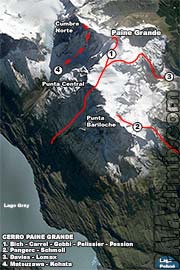
Cerro Paine Grande 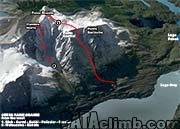
Cerro Paine Grande from the west 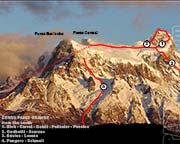
Cerro Paine Grande from southeast 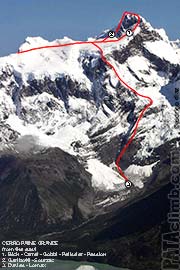
Cerro Paine Grande from the east 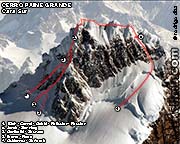
Summit pyramid from the south 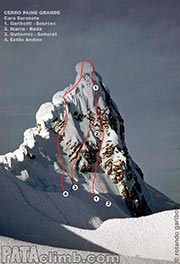
Summit pyramid from the southwest |
SITEMAP
If you find this web page useful, please consider making a donation
CLIMBING AREAS |
KNOWLEDGEDISCLAIMER COPYRIGHT CONTACT DONATE |
Climbing is dangerous, take responsibility, climb at your own risk. © 2010 Rolando Garibotti. All rights reserved.